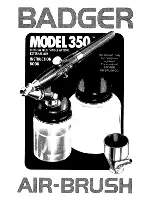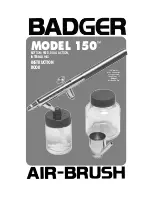
Operation
6
3A1186F
Operation
Pressure Relief Procedure
Follow the Pressure Relief Procedure whenever
you see this symbol.
1.
Engage the gun trigger lock. Refer to the separate
instruction manual provided with gun for safety fea-
tures and how to engage the trigger lock.
2.
Turn the unit off.
3.
Disengage the gun trigger lock and trigger the gun
to relieve residual fluid pressure.
Hold metal part of the gun in contact with
grounded metal pail. Use minimum pressure.
4.
Turn Prime/Pressure Relief Valve (PR Valve) to the
open (priming) position to relieve residual pressure.
There will be a wider gap between valve handle
and cam body when in open position. In the
closed position there is only a very slight gap.
NOTE:
The valve handle can move both clockwise and
counter clockwise and can face different directions.
5.
Re-engage gun trigger lock and close Prime/Pres-
sure Relief Valve.
If the
spray tip or hose is clogged
, follow Steps 1
through 5 above. Expect paint to splash into the
bucket while relieving pressure during Step 4.
NOTE:
If you suspect that pressure hasn’t been relieved
due to damaged Prime/Pressure Relief Valve, or other
reason, slowly loosen the tip nut or hose coupling.
Setup
Grounding
Always ground the following components:
•
Sprayer - Connect a ground wire and clamp (sup-
plied) to a true earth ground.
•
Fluid Hose - Use only grounded hoses.
•
Spray Gun of Dispensing Valve - Grounding is
obtained through connection to a properly grounded
fluid hose and pump.
•
Object being sprayed - According to local code.
Connect the hose and gun
1.
Remove the plastic cap plug from the outlet and
screw a conductive or grounded 3000 psi spray
hose onto fluid outlet.
2.
Connect an airless spray gun to the other end of the
hose. Do not install spray tip.
NOTE:
Do not use thread sealer on swivel unions as
they are made to self seal.
NOTE:
The 6’ whip hose should always be 3/8”.
This equipment stays pressurized until pressure is
manually relieved. To help prevent serious injury
from pressurized fluid, such as skin injection,
splashing fluid and moving parts, follow the Pressure
Relief Procedure when you stop spraying and before
cleaning, checking, or servicing the equipment.
ti15989a
ti14791a
ti14790a
Summary of Contents for 3A1186F
Page 21: ...Notes 3A1186F 21 Notes ...







































